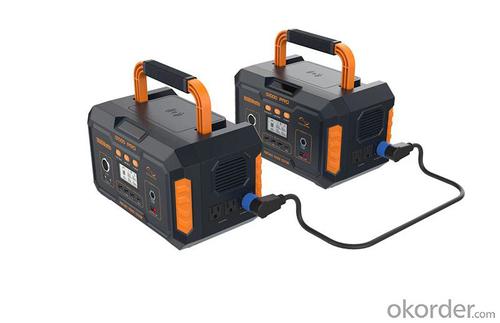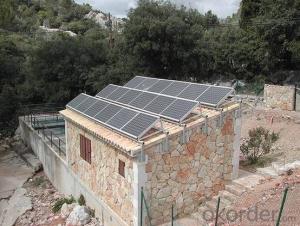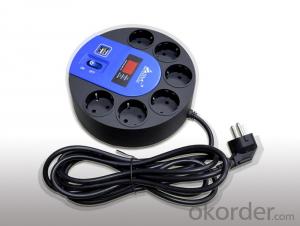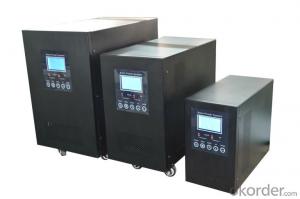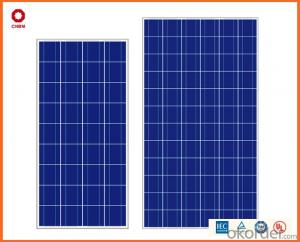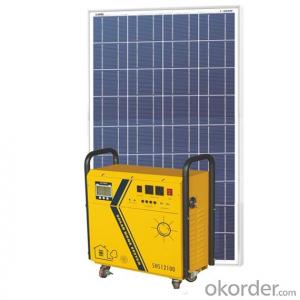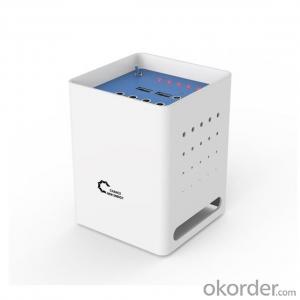oem ,odm ,500w, 1000w ,1500w lithium Portable home use solar energy system
- Loading Port:
- Shanghai
- Payment Terms:
- TT or LC
- Min Order Qty:
- 10 set
- Supply Capability:
- 5000 set/month
OKorder Service Pledge
OKorder Financial Service
You Might Also Like
Specification
This solar lighting system is ideal for places with no mains electricity such as outhouses, sheds, garages, farms, stables, as well as for camping, travel and any outdoor activities (e.g. a for a yurt).
The system is fully independent from the grid / AC power source and works purely based on sunlight energy.
During the daytime, the 12W solar panel charges a 12V battery inside the control unit, which then provides power to the 2 x 3W 12V LED lights connected via front sockets on the control unit.
In addition, there is a standard 5V USB socket for charging mobile phones and USB compatible devices (adaptors for USB-compatible mobile phones are included).
The control unit has a built-in 4Ah battery with an automatic solar charge controller to manage the charging process and prevent overcharging.
The 12W solar panel supplied with the system can fully charge this battery within about 7-8 hours of bright sunshine (longer in cloudy weather), and the battery can provide enough energy to power 2 LED lights continuously for 14 hours, or twice as long if only one LED lights are connected.
The system is very convenient to use and install: the solar panel comes with 5m cable and each LED light comes with 4m cable with an On/Off switch.
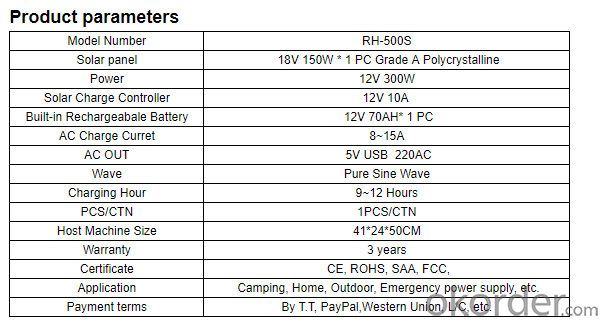
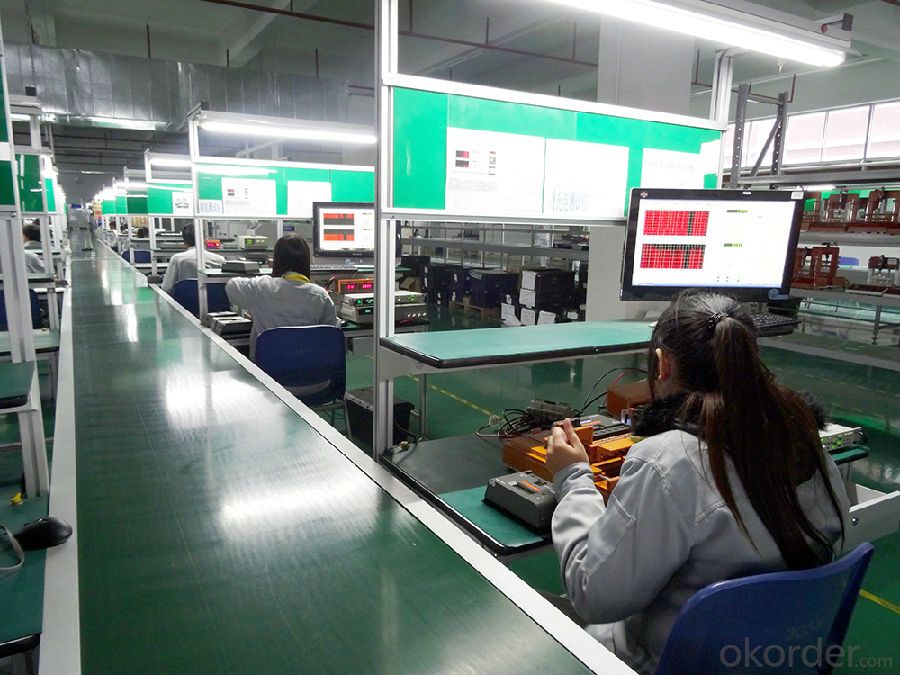
- Q: Can solar panels be installed on uneven or sloped surfaces?
- Yes, solar panels can be installed on uneven or sloped surfaces. However, the installation process may require additional components such as mounting brackets or frames to ensure the panels are securely attached and properly angled for optimal sunlight exposure.
- Q: Can solar energy systems be used in areas with limited access to solar grounding equipment?
- Yes, solar energy systems can still be used in areas with limited access to solar grounding equipment. Grounding is an important safety measure in solar installations, but there are alternative methods available to ensure the safety and functionality of the system. These methods may include using ground-mounted solar arrays, ground screws, or other grounding techniques that do not require extensive equipment or infrastructure. It is important to work with experienced solar professionals who can provide suitable solutions based on the specific circumstances and limitations of the area.
- Q: Can solar energy systems be integrated into building design?
- Building design can include the integration of solar energy systems. This approach is increasingly popular and is considered both sustainable and cost-effective for generating electricity. There are multiple ways to incorporate solar energy systems, such as using rooftop solar panels, solar facades, or solar windows. The most common method is installing rooftop solar panels. These can be standalone structures or integrated into the roof itself. They capture sunlight and convert it into electricity, which can power the building or be fed back into the grid. Solar facades are another option. These involve placing solar panels on the outer walls of buildings. Besides generating electricity, they also act as a protective layer, reducing heat gain and improving energy efficiency. Solar windows are a new development in building design. These windows have built-in transparent solar cells that capture sunlight and generate electricity while still allowing natural light to enter the building. They have the potential to revolutionize building design by seamlessly integrating renewable energy generation into the building envelope. Integrating solar energy systems into building design offers several advantages. Firstly, buildings can generate their own electricity, reducing reliance on fossil fuels and lowering utility bills. This also contributes to reducing greenhouse gas emissions and creating a cleaner environment. Additionally, solar energy systems can enhance the aesthetic appeal of buildings, making them visually striking examples of sustainable architecture. In conclusion, solar energy systems can be integrated into building design. With options like rooftop solar panels, solar facades, and solar windows, buildings can generate clean, renewable electricity, reduce their carbon footprint, and contribute to a more sustainable future.
- Q: Can solar energy systems be used for commercial purposes?
- Yes, solar energy systems can definitely be used for commercial purposes. In fact, many businesses and industries are increasingly adopting solar power as a reliable and sustainable source of energy. Commercial solar energy systems can power offices, factories, warehouses, retail stores, and other commercial establishments, helping reduce electricity costs, lower carbon emissions, and enhance the company's environmental image. Additionally, various financial incentives and government programs are available to encourage the commercial sector to invest in solar energy systems, making it an attractive option for businesses looking to go green and save on energy expenses.
- Q: Can solar energy systems be used in areas with high levels of light pollution?
- Yes, solar energy systems can still be used in areas with high levels of light pollution. While light pollution can reduce the efficiency of solar panels by obstructing direct sunlight, solar energy systems can still generate electricity even in less ideal conditions. It is important to note that the overall performance of the system may be affected, but advancements in solar technology and proper positioning of panels can help mitigate the impact of light pollution on solar energy generation.
- Q: What is the impact of saltwater spray on solar panels?
- Saltwater spray can have several impacts on solar panels. Firstly, the salt in the spray can create a layer of residue on the surface of the panels, which can reduce their overall efficiency. This residue acts as a barrier, preventing sunlight from reaching the photovoltaic cells and reducing the amount of electricity that can be generated. Secondly, the corrosive nature of saltwater can lead to the degradation of the materials used in solar panels. Over time, the salt can cause the metal components and connections in the panels to corrode and weaken, potentially leading to malfunctions or even complete failure of the panels. Additionally, saltwater spray can also affect the structural integrity of the panels. The constant exposure to saltwater can cause the materials to deteriorate, leading to cracks, warping, or other forms of physical damage. This can not only impair the performance of the panels but also pose safety risks. To mitigate the impact of saltwater spray on solar panels, it is essential to regularly clean and maintain them. This involves removing the salt residue and ensuring that the panels are free from any accumulated debris. Proper cleaning techniques and regular inspections can help prolong the lifespan of the panels and maintain their efficiency. Furthermore, selecting solar panels specifically designed for coastal or marine environments can provide added protection against saltwater spray. These panels are often constructed with materials that are more resistant to corrosion and have enhanced durability to withstand the harsh conditions. In conclusion, saltwater spray can have a negative impact on solar panels by reducing their efficiency, corroding their components, and compromising their structural integrity. However, with proper maintenance and the use of suitable panels, these effects can be minimized, allowing solar energy systems to continue operating effectively even in coastal or marine environments.
- Q: Can solar energy systems be used in areas with limited access to security?
- Yes, solar energy systems can be used in areas with limited access to security. In fact, solar energy systems can be particularly beneficial in such areas as they are decentralized and do not rely on a centralized power grid, making them less vulnerable to security risks. Additionally, solar panels can be installed in remote or inaccessible areas, providing a reliable source of clean energy even in locations with limited security infrastructure.
- Q: Can a solar energy system be connected to the grid?
- Yes, a solar energy system can be connected to the grid. In fact, many solar energy systems are designed to be grid-tied, allowing excess electricity generated by the system to be fed back into the grid. This enables homeowners and businesses to earn credits for the surplus energy produced and use it when their solar panels are not generating electricity, such as during nighttime or cloudy days. Grid connection also provides a reliable backup power source when solar production is insufficient.
- Q: Can a solar energy system be used to charge electric vehicles?
- Yes, a solar energy system can be used to charge electric vehicles. Solar panels can generate electricity from sunlight, which can then be used to charge the batteries of electric vehicles. This provides a sustainable and renewable source of energy for powering electric vehicles.
- Q: Can solar panels be installed on facades or windows?
- Yes, solar panels can be installed on facades or windows. Traditional solar panels are typically installed on rooftops to maximize sunlight exposure. However, there are now innovative solar technologies that allow for the integration of solar panels into building facades or windows. These technologies, known as building-integrated photovoltaics (BIPV) or building-applied photovoltaics (BAPV), enable the use of solar panels as part of the building's design and architecture. BIPV systems can be seamlessly integrated into the building's facade, replacing traditional building materials such as glass or cladding. This allows for the generation of solar energy while maintaining the aesthetic appeal of the building. BAPV systems, on the other hand, involve the installation of solar panels onto existing windows or as window coverings. These panels can be transparent or semi-transparent, allowing natural light to penetrate while generating electricity. Solar panels on facades or windows offer several advantages. Firstly, they provide additional surface area for solar energy generation, making the most of available space in urban environments where rooftop installations might be limited. Secondly, they can help to reduce a building's energy consumption by generating electricity on-site, thereby lowering reliance on the grid. Lastly, they contribute to the overall sustainability and eco-friendliness of the building, promoting renewable energy use and reducing carbon emissions. However, there are some considerations to keep in mind when installing solar panels on facades or windows. Factors such as the building's orientation, shading, and the quality of natural light need to be carefully evaluated to ensure optimal energy production. Additionally, the structural integrity of the building must be assessed to determine if it can support the additional weight of the solar panels. In conclusion, solar panels can indeed be installed on facades or windows through BIPV or BAPV systems. These innovative technologies offer numerous benefits such as increased energy generation, reduced energy consumption, and enhanced building sustainability. However, proper evaluation and planning are essential to ensure the effectiveness and feasibility of such installations.
Send your message to us
oem ,odm ,500w, 1000w ,1500w lithium Portable home use solar energy system
- Loading Port:
- Shanghai
- Payment Terms:
- TT or LC
- Min Order Qty:
- 10 set
- Supply Capability:
- 5000 set/month
OKorder Service Pledge
OKorder Financial Service
Similar products
Hot products
Hot Searches
Related keywords






